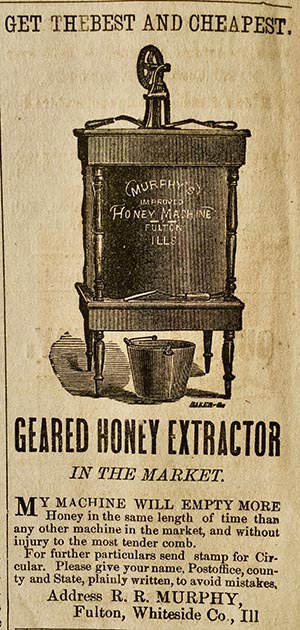
Old Southern bee journals are notoriously rare. Moon’s Bee World, published in Rome, Georgia, purely intrigued me from the first time I heard about it. Some decades later, I found just one year of the monthly journal, 1874, the second year of its publication. Artistically, the covers were ornately decorated (see Figure 1).
In my study of old beekeeping artifacts, the advertisements help document the development of beekeeping equipment. In the 1870s different honey extractor designs competed in the advertisements of various bee journals. In May 1874, an advertisement appeared in Moon’s Bee World showing “Murphy’s Improved Honey Machine, Fulton ILLS.” According to the advertisement, the script was written on the metal can of the extractor. The metalwork was set in a wooden table-like support. The legs and other vertical supports were fancy and elegant, like furniture, far more than just simple straight utilitarian rods that could have done the same job (see Figure 2).
Notice the Murphy extractor had no honey gate on the front, typical of later machines. On some early extractors, the honey flowed through a center drain under the can. A bucket below the extractor caught the honey as shown in the advertising picture. The gearing that rotated the frames could be adapted from butter churns, which were common household devices in those times. Another extractor of a similar style, wood and metal, appeared in June 1874 (see Figure 3). In the advertisement, A. Gray & Company touted they had 500 extractors. Notice both of these advertisers were from up North. Murphy was located in Illinois. Gray was in Ohio. In fact, many of the advertisers in Moon’s Bee World, Italian queen producers too, were from the Northern states.
I collect old honey extractors, which generally are difficult to find, probably because of limited sales, their hard-working lives, and storage space requirements, extending past a century for the wood and metal ones. Nevertheless, Figure 4 shows an extractor I found that is very similar to Murphy’s extractor shown in Figure 2. It is a four-frame non-reversible extractor that took standard size Langstroth frames (see Figure 5). (That long ago, frame sizes were not standardized and extractors took different size frames.) Notice the woodwork of the lathe-turned legs and tabletop style is similar to Murphy’s advertisement picture. This extractor has horizontal gearing instead of vertical gearing shown in the advertisement. Minor differences between pictures in patents, sales catalogs, advertisements, and the actual product were fairly common.
Another extractor advertised concurrently with the two above is an exotic one, announced as “GET THE LATEST, GET THE BEST. First Premiums Awarded in 1873 over all Competitors …” (see Figure 6). While the honey gate and bucket look familiar, the rest of the design deviates from a modern extractor. As best as I can tell, the crank handle removed from the can has the gearing in the wooden housing under the spinning frames. That left the top of the can without any obstructions, which could slow the work of replacing frames. I have never seen one of these extractors.
Like different extractor designs, the 1870s brought an array of frame shapes. Some beehives even had ….


